
Goofing around with the ringneck pheasant cape I got in the mail today from a friend who recently returned from a successful hunt in South Dakota.
Another month is upon us and while late fall/early winter is a great time to start tying up some patterns to restock the fly boxes depleted by another year on the water, lets not abandon the fishing quite yet. I have had several great days on the river this past month. It does get a bit hit and miss as the weather and the water temps cool but when you hit it right the fishing can be outstanding. I have still been running into some great baetis hatches around here and so with that in mind I thought I would share my favorite pattern when fish are sipping the Blue Winged Olive Duns off the rivers surface. This pattern is basically a Sparkle Dun with a biot body, and I use a CDC feather for the trailing shuck instead of Z-lon. I like the Sparkle dun because it is so versatile. I think fish feeding on emergers, duns, and spinners could all find a reason to take a well placed Sparkle Dun. This version is quite simple to tie, it floats well, and is fairly easy to see even in the small sizes that will often be required. Lets get started with the materials:
Hook: #18 or smaller Tiemco 100 or equivalent dry fly hook
Thread: Olive 8/0
Wing: Olive Deer Hair
Tail/Shuck: One Natural Brown CDC feather
Body: Gray Olive Turkey Biot
Thorax: Medium Olive Fine Dry Fly Dubbing
1) In the winter months the bugs that do hatch tend to be small. For our rivers in Southeast Idaho I usually tie this pattern in sizes from #18-#24. You can definitely go larger or smaller if needed.
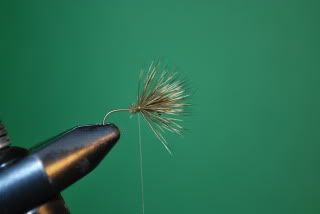
2) Tie in a clump of deer hair about 2/3 down the shank of the hook. I make about 3 good turns while holding the back of the hair so it stays on top of the hook while the tips flare out. Then clip the backs as close as you can at a 45 degree angle.

3) Next I pull up about 1/3 of the hair and make a wrap in front of it, then proceed to pull up another third, again making a wrap in front of that, then finally pull the remaining hairs straight up and wrap in front so that all the hair is standing up on the fly. Then be sure to build up a good thread dam in front of the wing as if you don’t, when the fly gets wet the wing will lean forward on you. Then wrap the thread back to behind the wing and tie down the loose ends on that side.
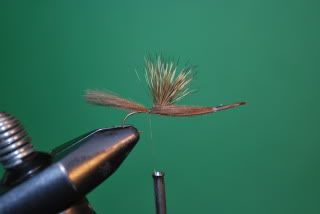
4) Now tie in the CDC feather on top of the hook shank. I don’t worry about how long the tail sticks out as I cut it later.
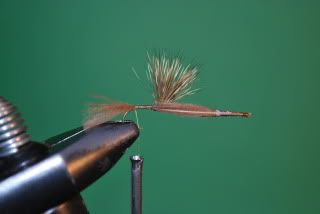
5) Continue securing the CDC feather wraping back to where the shank meets the bend.

6) Now I trim the tail to about 3/4 hook shank length.
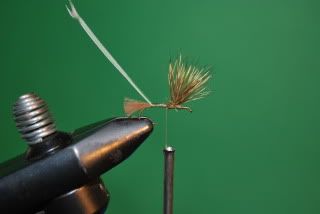
7) Next tie in a Goose or Turkey Biot Quill with the notch facing left. Advance the thread to just behind the wing.
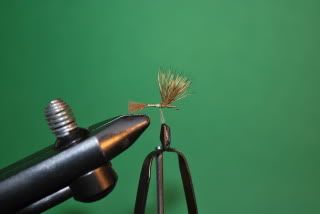
8) Wrap the biot using nice even wraps toward where you stopped the thread, then tie it off and clip the excess.

9) Next I simply dub a nice football shaped thorax using 2-3 wraps behind the wing and 3-4 in the front of it.
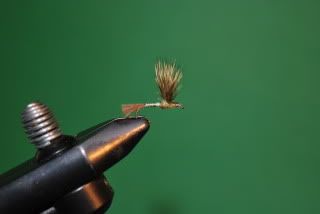
10) Finally make a nice even thread head and tie off the fly. Dab some head cement on there and you are ready to fish.
Play with the color scheme to match other mayfly hatches in your area as well. I like this pattern tied in appropriate colors for the summertime PMD hatches too. Most of all have fun and catch some fish!